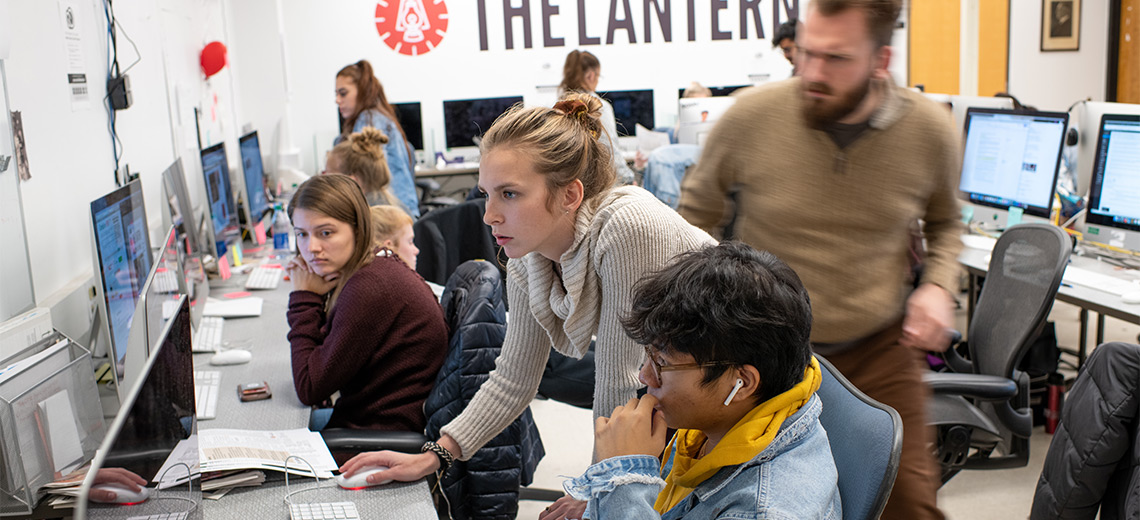Published first in the AEJMC Media Ethics Division newsletter
The Lantern thought it was covering a straightforward campus protest over racial injustice.
Within hours Ohio State’s student media was in the middle of a First Amendment fight.
It started with a public safety notice. The Ohio State reported two sets of students near campus had been called a racial slur and physically assaulted. They identified the suspects as Black but failed to ID the victims, who were white. Public safety resent the release and indicated the action was classified as a “hate crime” due to the racial slurs, which were not identified.
That prompted more than 100 demonstrators to gather outside the president’s office to protest racial injustice and call for equal protection of all students, claiming the safety notice negatively and unfairly impacted the perception of Black students on campus.
If there is news on campus, The Lantern is there to cover it, and they chronicled the protest, which included speeches from three people who also happened to be appointed members of the undergraduate student government. For all intents and purposes, the writers did a fair and accurate job of coverage.
Or so we thought.
The challenges began to surface with coverage of the second campus protest, a week later. Lantern reporters arrived on the scene and were surprised to find they were no longer just covering the story. They had become the story.
The protestors immediately faced the camera and proclaimed their names and faces were off-limits for coverage. They were not organizers, just participants. Their lives would be in danger if their faces and names were exposed. Despite protesting in public, they claimed a right to privacy.
The Lantern staff listened. We discussed our options, which included abiding by their requests, skipping coverage the event altogether or limiting exposure of protest attendees, but not speakers.
The staff decided on option 3. Images of the attendees would be shown from behind to protect their privacy. The speakers, however, had no such privacy protection, and their unobstructed images and names were included.
The result: The Lantern was said to be discriminating against students of color, a petition was launched calling for the media enterprise to be censured, and editor-in-chief Sam Raudins became the focal point of prejudice for many of our Black and brown students.
Covering protests was nothing new for our young staff. Just weeks after editors took over their roles as the 2020-2021 staff, George Floyd was killed in Minnesota, and Columbus was among many cities that exploded with rage at the injustice.
The Lantern staff was on the ground and in the fray as protest flooded Columbus’ streets, chronicling history from the statehouse to our campus streets.
They were front and center when protestors and police clashed at the northern entrance to campus just as a 10 p.m. curfew fell on Ohio’s capital city. Despite a curfew exemption for media and the clear display of their media credentials, those student reporters were pepper-sprayed point blank and even pursued in retreat by police with chemical weapons still flying—an event so grievous multiple entities filed citizen complaints with the police department.
As student-journalists, we train them to be ready for as many scenarios as we can—public meetings, data-driven investigations, family-focused features, even active campus shooters.
We did not, however, train them for what happens when the community they cover suddenly makes them a focal point and their coverage becomes a societal confrontation.
Our path forward was to continue to rely on the law and ethics that drive our training and our news execution.
Legally, our footing was firm. That which occurs in public is public. Protests are protected by the First Amendment, and so is the ability of the media to cover them.
As Frank LoMonte, the director of the University of Florida’s Brechner Center for Freedom of Information, noted in a June 4, 2020 Poynter piece, “As long as a journalist’s feet are planted in a place that is lawful to stand, a journalist is entitled to photograph or videotape anything they want, even closeups of faces. The short answer under U.S. law is that there is no such thing as being private in public.”
The ethics, however, were a bit more fluid.
Student protestors said concerns about faces being photographed and shared put them in danger, as police might use them for identification or future arrests, which is what professor and visual journalist Tara Pixley addressed in Nieman Reports on July 13: “Each image photographed, published, and circulated has the capacity to both inform a viewing public and inform the police.”
Our editors also considered the position taken by Kelly McBride, NPR public editor, who wrote in a June 18 statement, “Blurring images is a form of photo manipulation that makes them less true, and is generally an unacceptable practice for documentary photography.”
In the end, editor-in-chief Sam Raudins explained the rationale best in a letter to Lantern readers:
“We cover protests by any group, because it is news that happens on our campus. It is our charge and responsibility to cover movements that involve and impact the lives of students. We will report them accurately and fairly, and will uphold the same standard for every group that assembles on our campus.
“We want the message of these groups to be heard, and we want Ohio State students, faculty, staff and alumni to look back at The Lantern archives 100 years from now and understand what these times were like. That has been the mission of The Lantern since its inception, and it will be our mission every day moving forward.”
